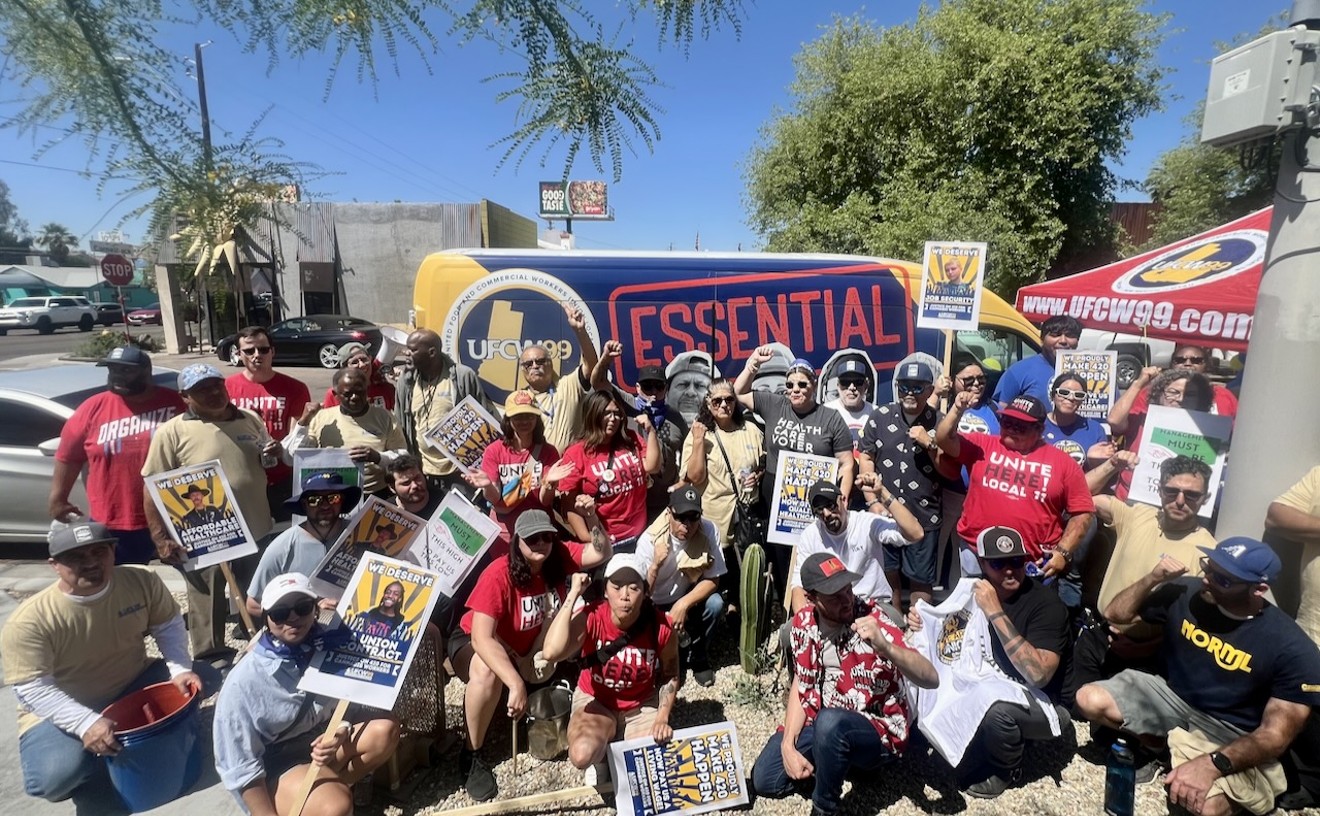That's a question that local Coca-Cola drinkers are facing with increasing regularity in small madre y padre Mexican restaurants around the Valley as they're offered a choice of two varieties of Coke when they order that beverage with their meals.
One choice is a domestic Coke, the same stuff you've probably been drinking for years. It's usually served from a can or already poured into a glass from a fountain; both are products of the Phoenix Coca-Cola Bottling Plant in Tempe.
The other choice? A scuffed bottle of Coke from below the border, emblazoned with the words "Hecho en Mexico" and--more important--containing a foreign fizz that many Cokeaphiles swear packs a bigger wallop than its U.S. counterpart.
But is the south-of-the-border stuff really worth the premium price that Mexican fizz freaks claim it to be? Mexican Coke can be as much as 50 cents more than its domestic counterpart in some locations, a markup said to cover import charges.
Plenty of people seem to think it's worth it. One local importer (who declines to reveal his name) claims he makes trips to an unspecified Mexican bottling plant every few weeks, bringing back as many as 1,000 cases a month to fill orders in the Valley. Until recently, he was reportedly servicing nearly 40 Valley restaurants, several Mexican grocery stores and a handful of private customers, like the family of four who guzzled its way through 60 cases every two months.
Still, observers like veteran Valley restaurateur Norman Fierros can't help wondering why someone doesn't just put a lid on the Mexican Coke fad. "The whole thing is stupid," says Fierros, who serves only domestic soft drinks in La Pila, his latest Mexican food restaurant. "I've tasted the Mexican stuff and there's no difference that I can taste. It's exactly the same stuff you can buy up here."
"No way, Jos!" counters one doubting Tomasina.
"There is a definite taste difference," contends Maria Lucero, owner of Rocky Point Restaurant, a small Mexican seafood eatery on South Central Avenue. Lucero sells nearly 250 bottles of imported Coke a week from one of several Mexican Coke runners currently operating in the Valley. "The Coke from Mexico is sweeter--maybe not a lot sweeter, but enough that you can tell the difference from the kind you buy in this country. Most of our customers are Hispanic, and if they order Coke, they'll order the kind they used to drink in Mexico."
"The customers tell me it has more fizz," adds a waitress at Lucero's restaurant. "The people that order it tell me the stuff up here doesn't have nearly the same kick."
Or so one Anglo restaurateur discovered when a female importer convinced him to carry 16-ounce bottles of Mexican Cokes and other Mexican soft drinks in order to add authenticity to his Mexican eatery two years ago.
"When I first decided to carry the stuff, it was just kind of to add a little atmosphere," confesses Dennis Sirrine, owner of Rosa's Tacos, a Mexican restaurant in a Mesa strip mall.
"But now we get people in here who refuse to drink anything else," continues Sirrine, who admits the slightly sweeter Mexican cola doesn't taste different enough to "knock you over the head." Still, Sirrine claims his restaurant now sells 13 cases (312 bottles) a week, primarily to his Hispanic customers.
Ironically, at least one supplier insists that the Mexican Cokes actually owe their popularity to the fact that the imported fizz is actually milder than its domestic counterpart. In addition to claiming that the imported stuff contains less--not more--sugar than the U.S. variety, the fizz-runner also insists that the Mexican pop contains far less "gas" (carbonation) than does its domestic counterpart.
(Forget for the moment that the importer has just provided a pretty accurate description of what most domestic consumers would consider an unappetizing "flat" Coke.)
Addressing the all-important "belch" factor, the importer explains, "When you drink a Coke from here [the U.S.], you can't take more than one or two drinks before you have to stop because there's so much gas in it. That's why you can sit and drink two, three or four bottles of Mexican Coke during one meal."
While one ponders the benefits of consuming massive quantities of any sugar-laden beverage in such a short period of time, other observers offer far more feasible reasons for the Mexican soda's popularity among U.S.-based Hispanics.
"Who wants to drink out of a can?" asks one importer. "The Coke up here--it tastes like chrome."
Like virtually every other soft drink produced in the U.S., Coca-Cola is now marketed almost exclusively in cans, plastic containers and syrup canisters used to produce the fountain-style Cokes, such as those sold at convenience markets. (Last year, Coke did reintroduce eight-ounce glass bottles in old-fashioned, cardboard six-pack holders, but at $1.50 a bottle, the pricey novelty was clearly aimed at the Coke elitist, not the average consumer.)
In Mexico, however, Coke-under-glass seemingly continues to be the norm and some observers speculate that for many Mexicans, the beat-up bottles represent a liquid link to their homeland, a carbonated security blanket. "The Mexican viewpoint seems to be that everything's better from home," says Norman Fierros of La Pila restaurant. "It's just their imagination."
Although it's hard to believe (surely, at least one Coke deliverer must have spotted a case of Mexican Cokes during his restaurant deliveries somewhere), sources at the Phoenix Coca-Cola Bottling Plant claim to be totally unaware of the Mexican import sales in the Valley. Furthermore, it is not that surprising that no one in the local Coke office was able to definitely answer any questions regarding possible differences in taste between foreign and domestic product, either.
From Coca-Cola's corporate headquarters in Atlanta, Georgia, the answer to that question is a resounding "maybe."
"Coca-Cola has excellent quality control," reports media spokesperson Bill Hensel, who explains that the company's quest for uniformity even extends to the use of a complex water-filtration system that guarantees that a Coke bottled in Moscow is indistinguishable from one manufactured in Madison, Wisconsin.
Still, Hensel claims there's one fly in the Coke syrup--and that's the difficulty of obtaining a uniform sugar product for use in its far-flung empire.
"We use different sweeteners in different parts of the world," explains Hensel, who confesses that may account for the perceived difference between American and Mexican Cokes. "Basically, though, they should taste pretty much the same wherever you drink it."
However, some seasoned travelers find that claim exceedingly difficult to swallow. One Valley woman who spent her adolescence in Spain swears that the only resemblance of that country's version of the popular potable to the one sold in this country was the shape of the bottle, while New Times' restaurant critic Howard Seftel recalls drinking a Coke in Mauritania that had "the consistency of ketchup." Still, Hensel can't resist propping up his argument by trotting out Andy Warhol's old adage about the libation, "A Coke is a Coke is a Coke." And after all, the Coca-Cola reasoning seems to go, who should know better than a pop artist?










